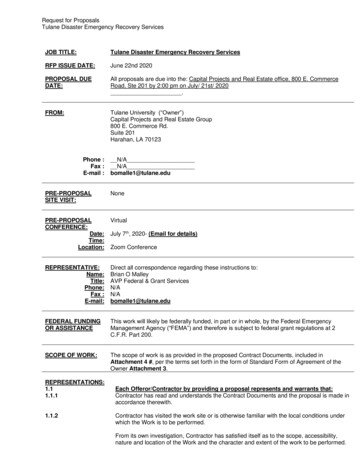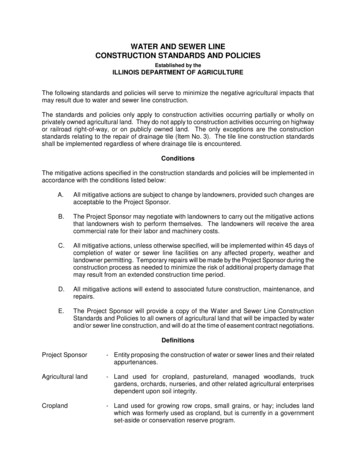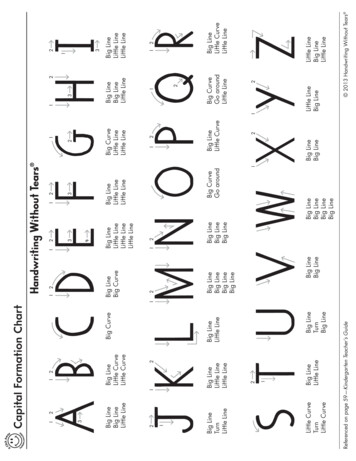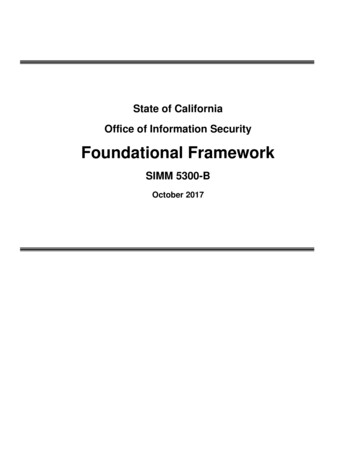
Transcription
SECURITY CONCERN AND ON-LINE SHOPPINGVasja Vehovarvasja@ris.orgUniversity of Ljubljana, Faculty of Social SciencesAbstractThe paper overviews the relationships between concern for security and on-lineshopping. The issues of confidentiality, privacy and credibility are also briefly discussed.Despite some recent turbulence, the on-line shopping is steadily growing, surpassing 1% ofretail sales in some most developed countries. Of course, the indirect effect of on-lineshopping information is much larger.Second, the data from SIBIS project for 25 European countries and US are presentedwith special attention to the relation between e-shopping, security, privacy and Internetdevelopments. The relation between the Internet developments and on-line shopping seems tobe strongly linear. However, the security concern, and - in particular - its impact on on-lineshopping, exhibit much more complex relation, which is strongly conditioned on specific(cultural) country characteristics. No simple linear correlation can be observed between thisconcern and the extent of on-line shopping or Internet usage.More detailed individual data from Slovenia enabled the modeling of the causalrelation between security concern and on-line shopping. It is shown, that on individual levelthe on-line purchase is basically determined by attitudes towards e-shopping and not so muchwith security concern and the intensity of Internet usage. There are also some importantdifferences if data are used from representative telephone survey, or, from the self-selectedsurvey on the Web.The specific data on Slovenia are also presented, showing a typical country withmodest internet penetration (40% of the population 15 ) and relatively slow development ofon-line shopping, where the privacy and confidentiality concern did not yet develop to theextent that would present a serious obstacle. However, the consumer attitudes reveal somesurprising issues. Thus, for example, the navigation of the on-line shop seems to be the mostimportant characteristic of a good shopping Web site (before security and privacy assurance).Similarly, among the complaints related to the consumer rights the most exposed one was theproblem that the Web site was not enough user-friendly.1
CONCERN FOR security AND ON-line shopping . 11introduction . 32on-line shopping and confidentialiy concerN: SIbis data . 8342.1On-line purchases over the Internet . 82.2Security concern as the obstacle of on-line shopping behaviour . 102.3Privacy and security concern and on-line shopping. 13security/ privacy and on-line shopping in Slovenia . 173.1The basic characteristics. 173.2Segmentation of on-line shoppers . 253.3Preferred characteristics of on-line shopps . 263.4Obstacles to on-line shopping . 283.5Consumer rights issues. 30modelling security concern and on-line shopping. 312
1INTRODUCTIONDespite serious turbulences in recent years that caused substantial shrinking of theinformation technology sector (and particularly in the so-called dotcom industry) theelectronic commerce in steadily growing. Of course, the brave five-year forecasts ofconsulting agencies from mid 90’s did not come true. Similarly, many visions of digitalsociety, from Being Digital (Negroponte, 1990), Third Wave ( to What Will Be (Dertousoz,1995) become somehow more remote. However, there still exists an increasing integration ofthe information and communication technologies (ICT) into the life of the citizens as well asinto the business practice of companies.In this paper we basically focus on specific aspect of electronic commerce. We thus discussthe on-line purchase, which is also covered with the term of B2C (Business to Customer) ecommerce. Here, the relations among some key important underlying concepts (e.g. electroniccommerce, electronic business, internet shopping, on-line shopping, on-line purchase, etc) areoften very complex, overlapping and sometimes also confusing. As our focus here is veryspecific, we will omit the more general discussion of these concepts and focus immediately onthe empirical evidences.Thus, let us start with the latest release of the U. S. Census Bureau of the Department ofCommerce, which publish quarterly estimates on-line retail. The recent estimate of the U.S.retail e-Commerce sales for the first quarterly of 2003 was 11.921 billion, an increase of 26percent from the first quarter of 2002. Therefore, e-Commerce sales in U.S. in the first quarter3
of 2003 already accounted for 1.5 percent of total retail sales1. An economic phenomena thatexhibit 25% annual growth is no doubt rapidly expanding, however, this is still a dramaticslow down from early years of internet adoption when annual rates were above 100%. Thecurrent annual growth of 25% is thus still extremely large, however, we now face a relativelypredictable growth, which means that for a doubling at least 3-4 years are needed.Figure 1: Quarterly U.S. On-line Retail Sales in Mio USD: Total and E-commerce (Surce: US Censu Bureau)Here, we should add that within the framework of existing technology, the expert estimates ofthe potential of on-line retail is typicall limited with 10% of the total retail. However, withadditional and unforseen technological changes (multimedia, broadban, mobile,.) this limitmay radically change.We found the U.S: Census Bureau definition operational enough, so that we do not elaboratethe definitional issue in further details. According to Census Bureau, the On-line (or eCommerce retail sales) are the sales of goods and services that correspond to the orders placedby the buyers on-line, or, by the prices and terms of sale are negotiated on-line. Here, the 4
line” notion includes Internet, Extranet, Electronic Data Interchange (EDI), electronic mail, orother on-line system. We should add that the above definition exclude the on-line gamblingand on-line sex industry as well as the on-line travel *to sem že zadnjič napisal dapreverite*!!!Payment may or may not be made online as seen2 in the Figure 2. In order for electronictransactions to take place, it is thus necessary only that at least the ordering step is carried out(SIBIS, E-Commerce, 2002: 8), what creates another characteristics for further structuring ofon-line saels (in Slovenia, for example, only 20% of on-line orders are also paid on-line),**Figure 2: The matrix of the definition of electronic commerceIn addition, we should recall, that the customers may use the Internet only to collect theinformation, but actual purchase may be performed off line. Let us illustrate this simple factwith a table of rough estimates for Slovenia, where the on-line retail is still only in the earlystage of development. We can thus observe that the on-line retail has a very minor share(0.2% compared to 1.5% in US) in the total retail, however, the much larger share iscontributed to the off-line purchase generated with on-line information gathering. These all,of course, pose many question to the definition and the scope of the B2C electroniccommerce.**Figure 3: The on/offline information gathered and on/offline order – the estimates for the total retail sales2ibid.5
From the consumer point of view, the on-line purchase is heavily linked with the issues ofcredibility, security, privacy and confidentiality. While the credibility affect also the use ofon-line information for the corresponding on-line and off-line purchase, the concern forprivacy, confidentiality and security basically relates only to the on-line purchase. Let usbriefly introduce these four notions: One of the most common worries with creating efficient and trustworthy on-linecommerce concerns the security of financial transactions which occurs over the network(Palubo and Herbig, 1998: 258). The concerns are not merely about security of value, butalso about the trust in information society (Udo, 2001: 165). Credibility on the web is closely connected to the process of gathering onlineinformation, which should be accurate, comprehensive, based on expert opinion, andcomprehensive3. Further on, when using websites to obtain information consumers areoften asked to divulge personal information. The disclosure of identity of consumers is usually a privacy issue obstacle when shoppingonline. The Privacy@net4 study revealed that far too many sites collect personalinformation from consumers without providing adequate protection of that information.The latest Consumers International research on web credibility emerged that 39 percent ofsites that collected personal information did not have a privacy policy5. Confidentiality**dodati bolj precizne definicije the pojmov Matej3Consumers international, 2002, Credibility on the web, international study of the credibility of consumerinformation on the internet.4Consumers International, 20015Consumers International’s “Credibility on the web” study6
In this paper we will basically deal with the confidentiality .***7
2ON-LINE SHOPPING AND CONFIDENTIALIY CONCERN: SIBIS DATAWe will illustrate some of the above concepts with the latest findings of the SIBIS project(Statistical Indicators Benchmarking the Information Society), funded by the EuropeanCommission under the ‘Information Society Technology’ FP5 Programme, running fromJanuary 2001 to June 2003. Within the SIBIS project a General Population Survey (n 1,000per country) was conducted in 2002/2003. There, the comparisons of 10 EU accessioncountries (January 2003) are available with EU-15 countries and also with Switzerland andthe USA (June 2002).SIBIS indicators focus on e-commerce and on barriers related to security problems forconsumers. The indicators usually explore the causality link between the perception ofsecurity problems and the decision to buy online, confirming that the link is rather strong. Weare presenting here the results of the research on e-Commerce and security/privacy concerns.2.1On-line purchases over the InternetOn average, 20% of the EU's population 15 years and more) purchase products online. Here,the term “e-commerce” relate to any *dajte question wording Among the candidatecountries, only Estonia comes close to this figure. Some more advanced candidate countriesare on a comparable level with less developed EU15 countries (Spain, Greece and Portugal),with the majority falling radically behind. Buyers tend to display a more interactive use on thePC, suggesting more sophisticated and pioneer Internet users purchase online. Even so,occasional users are representing an increasing proportion of e-Commerce users, especially inthose countries with increasing online tenure and experience.8
eCommerce users(% of population)504540353025201510Regular RLNLFINSUK0DK5Occasional userFigure 4: E-Commerce users, SIBIS GPS 2002, SIBIS GPS-NAS 2003The figure bellow shows that the percentage of e-commerce usage is linearly growing withthe Internet penetration.e-commerce usage (in % of RO BG001020PEL30CZFIN NLLBI10IRLEEFNAS-10DSIELV405060708090Internet usage (%)Figure 5: E-commerce usage and internet usage, SIBIS 2002, GPS, SIBIS 2003, GPS-NASOne of the most dynamic groups of e-Commerce users is the 25-49 age class. They representa driving force of e-Commerce users across the EU. In the EU, this age group (28% of it aree-Commerce users) is by now as or more likely to be e-Commerce users than the Internet9
pioneering younger age group (25%). Only about 5% in the majority of the NAS countries aree-Commerce users at all. Here as well, the most important market segment is the 25-49 agegroup. And the same trend is to be noticed among US e-Commerce users. *nejasno celodstavekThe length of online usage and experience, or online tenure, is a critical aspect for thedevelopment of e-Commerce. The SIBIS survey shows that at least two years experience isrequired to be a more adept e-Commerce participant. SIBIS revealed that almost one sixth ofthe EU-15 could be classified as having significant online tenure, although this is somewaybehind the US. Conversely, many NAS have limited online tenure, although Estonia andSlovenia have encouraging profiles. Online tenure also has implications for the goal ofincreased broadband, as SIBIS analysis showed more experienced users tend to migrate tofaster Internet connections.2.2Security concern as the obstacle of on-line shopping behaviourInformation security is increasingly recognised as vital element for ensuring wideparticipation in the Information Society. The success of the Information Society depends upontrust and confidence in our information infrastructures. Within this context, the effects of real(or perceived) security problems inhibit the development of the Information Society and of eCommerce as a whole.Consumers are generally concerned both about privacy/confidentiality and data security.Privacy is the basis of human dignity and other human rights and values, like freedom ofjoining and freedom of speech. Some authors of liberal tradition even claim that all human10
rights are some aspects of right to privacy. Privacy is one of the most important rights incontemporary west society, as found in Privacy & Human Rights 1999 report.6Threats to privacy increased in seventies with emerge of information and communicationtechnology. As found in Privacy & Human Rights 1999 report, privacy is today threatenedmostly by three important trends: globalisation (removes geographical restrictions in flow ofdata), convergence among technologies and multi-media.7Privacy is not one-dimensional concept, and different aspects of privacy are threateneddifferent way. The most endangered in contemporary society are especially informationprivacy (possibility that individual keeps information about himself private) and privacy ofcommunications, which also includes data transactions.SIBIS 2002 Topic report on Security and trust shows there seems to be a fairly equaldistribution between those who declare themselves to be strongly, somewhat or not affected atall by their security and privacy concerns. The data indicates that improved securityfunctionalities by on-line operators foster electronic commerce. This clearly emerges from thehigh degree of respondents admitting that their concerns have an impact on their choices inthis area. However, other factors should also be assessed. There are a large number ofrespondents who do not seem to be affected by electronic breaches or vulnerabilities. Apossible explanation is that these respondents are more aware of e-commerce security featuresand, consequently, are more confident in completing on-line transactions.67Privacy & Human Rights 1999, w.html, May, 23 2000.ibid.11
However, on the whole, the value SIBIS adds in this area is to enhance the realisation thatbetter security will not be the panacea for the success of electronic commerce. Security needsto be considered as part of a set of activities or initiatives aimed at fostering a “customeroriented society”, which is based on consumers’ needs and wants. It is in particular the lack oftrust that seems to hold consumers back from shopping at the electronic marketplace.Concerns (particularly on privacy) seem to be lower in continental EU Member States andespecially in most of the NAS countries – with Hungary as the lowest – than in the UK,Ireland or the US. The clear outsider from the general NAS tendency is Poland, where theshare of Internet users stating they are “very” or “somewhat concerned” about data beingmistreated is the highest of all countries. Differences between countries are likely to be causedby a large number of factors including the amount of negative experiences, the level of trust inthe state and the functioning of society-at-large, and the level of awareness of issuessurrounding data protection and privacy. Nevertheless, despite these differences, there exist ahigh correlation between the privacy concern and security concern.60Eprivacy and confidentiality (%)50PLEU-15EL LV40B 5data security (%)Figure 6: Concerns regarding on-line security, SIBIS GPS 2002, SIBIS GPS-NAS 2003 *labele12
The figure below shows that the privacy and confidentiality concern does not necessarilygrows with the internet penetration. In Nordic counties the concern is low in spite of highpenetration. In NAS 10 countries the penetration and the concern meets at around 30%.Obviously, there exist other (i.e. cultural) factors. We do not show the relation among securityconcern and internet usage, as we saw from the picture above, that the correlation securityprivacy is very high60EIRLprivacy and confidentiality (%)50EL EE10BG00102030405060708090Internet usage (%)Figure 7: Privacy and confidentiality concern and internet usage, SIBIS GPS 2002, SIBIS GPS-NAS 20032.3Privacy and security concern and on-line shoppingSecurity concerns have a significant impact on online shopping behaviour of European andUS citizens. The figure below shows that the usage of e-Commerce is lower in countrieswhere the privacy and confidentiality issues are larger. This is especially true for NAScountries. The privacy concerns are high also in USA and UK where e-commerce penetrationis nearly 50%. It is somehow surprising that the concern seem not to correlate with on-lineshopping, although we can expect this already form the previous figure (concern and Internet13
usage). However, we could say that exist a trend among EU-15 countries, if we excludeScandinavian countries, while with NAS 10 countries there seem to be no correlation.60USAELVprivacy and confidentiality ZHUDKNLSEE10BG005101520253035404550e-commerce (%)Figure 8: Privacy and confidentiality concern and e-commerce, SIBIS GPS 2002, SIBIS GPS-NAS 2003We get more insight if we observe the customers stopped from on-line buying due to securityconcerns. In the EU, on average, nearly a third of Internet users do not buy online due tosecurty concerns. However, evidence suggests that there is a clear split between "frontrunners", where online shopping usage is high and the impact of security concerns isrelatively low (quadrant I) and the "laggards", where online shopping usage is low and theimpact of security concerns is strong (quadrant III). As can be seen, the Nordic countries, theUS, the UK, Austria and Germany appear as front-runners, while all Mediterranean countries(France, Italy, Spain and Greece) are the laggards. In comparison, all of the Central and EastEuropean candidate countries are located in the quadrant II, which means low online shoppingusage and relatively rarely kept from online shopping. This may be caused by lower usage ofonline shopping and less possibilities for e-Commerce in these countries. On the other handthe lowest percentage of the users14
Security concerns and online shopping usage(% of regular Internet users)70IIVUSOnline shopping rs who were often stopped from buying online due to security concernsFigure 9: Security concerns and on-line shopping usage, SIBIS GPS 2002, SIBIS GPS-NAS 2003Here we can observe a surprisingly low correlation among the general privacy/confidentiality(also security) concern and the fact that the consumers were actually stopped from buying dueto there concerns. Nevertheless, we can observe two clusters (EU-15 and NAS.10) wherethere does exist such correlation and the corresponding slope is extremely high.*** dodate tukaj še security concern and users stopped pri tem zamenjajte absciso inordinato60USA50privacy and confidentiality (%)EIRLLVELPLUK40EU-15ROP30BLANAS-10NL DKSK20SICZHU LTEE10IDFFINSBG0051015202530354045users who were often stopped from buying online due to security concerns (%)Figure 10: Users who were often stopped from buying online due to security concerns, SIBIS GPS 2002, SIBISGPS-NAS 200315
Respondents already concerned about security were asked whether this was a barrier stoppingthem from buying online. Interestingly enough, answers were polarised, with one third ofrespondents saying "yes, often" and another third saying "no, never". The remaining thirdchose a middle way answering "yes sometimes".8 The elaboration by country shows someinteresting variations which could descend from cultural differences. There are four countries(Italy, Switzerland, Greece and France) where respondents declaring that security concernsprevent them "often" from online purchases are approximately 40% of the total, andrespondents "never" concerned are slightly less than the EU average. This is not a NorthSouth divide, as it often happens for Internet indicators. Respondents who never let securitystop them from buying online are in the main from Spain and Portugal, as well as theNetherlands and Belgium.The conclusion is that security concerns are no doubt important barrier against e-commercefor a specific segment of the public, and more so in certain countries. SIBIS elaborations pointout that these "over-cautious" users cannot be identified by age, sex or professional status(even if younger users do tend to be less worried). *lako pgledate osnovno sociodemografijokar za cello bazo skupaj, predvsem izobrazba, leta uporabe, stareost, spol.It is possible in fact that the simple improvement of web sites security features may not besufficient, without specific communication and marketing campaigns. Useful input couldprobably come from marketing research and understanding of cultural specificitiesaccumulated in the financial sector for payment instruments such as credit cards. Although8SIBIS topic report on Security and Trust analysed this indicator by age and professional status, without findingvery significant variations to this pattern.16
among cultures ‘privacy’ has different meanings and importance, one must be aware that .tukaj tisti snapshot (3SECURITY/ PRIVACY AND ON-LINE SHOPPING IN SLOVENIA3.1The basic characteristicsWe already saw that Slovenia is around EU average in general ICT usage, however, muchbellow with respect to e-shopping. The gap can be attributed to the following: The awkward developments in the key on-line segments (books, music, retail) whatcaused the unique situation when the top on-line shops are from clothes (Neckermann)and home improvements/appliances (Merkur). The lack of the critical mass needed to develop more elaborated on-line shops.Nevertheless, the telephone survey from December 2002 showed that year 2002 was thecrucial year for Slovenian e-shopping due to the following reasons: the overall increase of the percentage of e-shoppers among Internet users (from 13%in 2001 to 16% in 2002). the increase of the percentage of active internet users (28% of the total Slovenianpopulation in June 2002) the radical increase of domestic on-line spending which consequently increases the absolute number of e-shoppers.The in depth RIS 2001 Web survey (15,000 respondents among Slovenian internet users)showed that almost 40% of respondents (more intensive internet users) did use e-shopping in17
last 12 months. One third of them used only Slovenian servers, 40% only foreign servers andanother third used both, Slovenian and foreign servers for e-shopping.Number of e-purchasersOur definition of e-purchase is that it is every purchase, which is ordered, but not necessarilypaid on-line. In December RIS 2002 research about e-purchasing it was found, that share ofinternet users, which purchased at least one thing on-line is stable, except for June (when was21% in 2002). The increase of average cash value of on-line purchases has also been noticed.Dec. 20021288June 20022180May 20018713April 20018713March 20018911Jan. 20018515Dec. 20008416Nov. 20001090Oct. 20001387June 200016830%20%40%No60%80%100%YesFigure 1: E-purchasing among monthly internet users in last 12 months (June 2000, n 216; October 2000,n 315; November 2000, n 410; December 2000, n 494; January 2001, n 338; March 2001, n 341; April2001, n 564; May 2001, n 453; June 2002, n 235; December 2002, n 87).It was also found that Mayority of persons accoplished only e-purchases on slovenian sites.18
100%90%19%37%80%70%only foreign countries60%27%50%40%81%Slovenia and foreignonly in Slovenia30%20%37%10%0%RIS 2002RIS 2000Figure 2: Shares of e-purchasers according to place of e-purchase (December 2002, n 48).This is the result of high increase of less educated active internet users, which also explainsincrease in share of domestic e-purchases, because it was found that new users are visitingmostly Slovenian websites. Despite of high increase of e-purchases, e-purchasing (in last 12months) is limited only to 7% of Slovenian population among 12 to 65 years and there is alsonotable a clear trend of on-line purchases in Slovenia only.7,00% in total 00Yes, but not in SIYes, and also in SITotalFigure 3: Share of e-purchasers in total population (RIS, June 1999 – June 2002).Further analysis found out that among people e-purchasing is more male persons, people withhigher education and daily or more frequent internet users.19
Comparative to other european countries (comparison was made on data from FlashEurobarometer, Eurostat and RIS) Slovenia is on the european tail; Slovenia also lags belowEU average.Share of internet users e-purchasing 212115141498GBGermanSw yLu edexe nmburgDThene N maed rkerlandsEU15AustriFi anlandFranceIrela**nd*Slo Belvegiunia( mRISSPo )rt ugalSpain(*Ita**lySlo v Greenia ece(ESS))0Figure 4: Share of internet users e-purchasing – comparison between SLO – EU (June, 2002). The mostcomparable for Slovenia are RIS data.Average cash value of e-purchasesSurvey from December 2002 has shown, that about half of the respondents accomplishedpurchases in an amount to 20.000 SIT, good quartile of them accomplished purchases in totalamount from 20.000 to 50.000 SIT and other in greater values. Comparative to other surveysthe results are not very different, but it was observed a decrease in purchases up to 10.000 SITand an increase of purchases valued up to 20.000 SIT.20
11dec. 20023214junij 200220maj 200138apr. 200139jan. 20012830do 10000 SIT1727330%23262220%10000-20000 SIT141760%20000-50000 SIT125671014148152240%723222527mar. 2000142234dec. 20001880%50000-100000 SIT100%več kot 100000 SITFigure 5: Cash value of e-purchases (March 2000, n 64; December 2000, n 32; January 2001, n 59; April2001, n 68; May 2001, n 51; June 2002, n 44; December 2002, n 57).It has also been found, that average amount of cash used for e-purchases dramaticallyincreased for purchases in Slovenia in June 2002, which is a consequence of increased epurchases in Slovenia.Average value of .18857.95848.26350.00040.00037.91430.00036.215also in Slovenia44.40841.70736.208only in foreign24.34120.00010.0000Dec. 2000Jan. 2001April 2001May 2001junij 2002Figure 6: Average cash value of e-purchase acording to place of e-purchase (December 2000, n 47; January2001, n 57; April 2001, n 73; May 2001, n 57; June 2002, n 44).21
Increase in average cash value of e-purchases and number of e-purchasers also caused anincrease of e-consumption.E-consumption97,98in billions SIT765432121,50,701999200020012002yearFigure 7: E-consumption in Slovenia from 1999-2002 (source: RIS surveys).PaymentMajority of e-purchasers (83%) paid by a “cash to delivery” method in June 2002, and only13% of them used credit card. Comparative to December 2000, there is an increase ofpayment by cash-to-delivery, but this could be a result of a fact, that number of e-purchases inSlovenian stores, which enables that method, is increasing.How did you pay?13junij 200283jan. 200127dec. 2000280%10%36766020%by credit card30%40%by ion onlyFigure 8: How respondents usually pay (December 2000, n 25; January 2001, n 33; June 2002, n 30).Credit card numbers were mostly transferred using SSL (secure) websites.22
foreign sitesslovenianHow credit card humber was transferred?73RIS 2001364RIS 19983201181RIS 20010%10%WWW with "secure server"20%30%40%610769RIS 1998250%WWW without "secure server"60%51970%80%WWW - dont know how1151790%by e-mail100%by faxProducts and services purchasedE-purchasers were mostly (43%) buying clothes and sport equipment in last 3 months (foundin June 2002 RIS survey), but number of books purchased decreased to a weak third ofrespondents.All respondents (those who purchased and those who don’t) were also asked in whichproducts and services are most interested to purchase or search buying information about.Most interesting are travel reservations, books and CD’s, and less interestin
shopping information is much larger. Second, the data from SIBIS project for 25 European countries and US are presented with special attention to the relation between e-shopping, security, privacy and Internet developments. The relation between the Internet developments and on-line shopping seems to be strongly linear.











